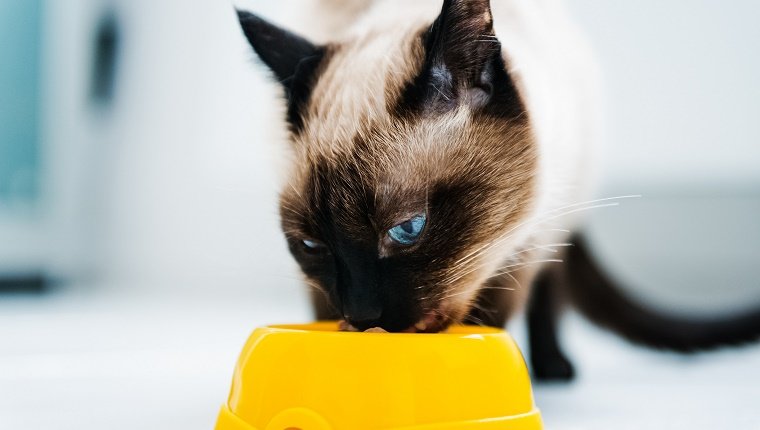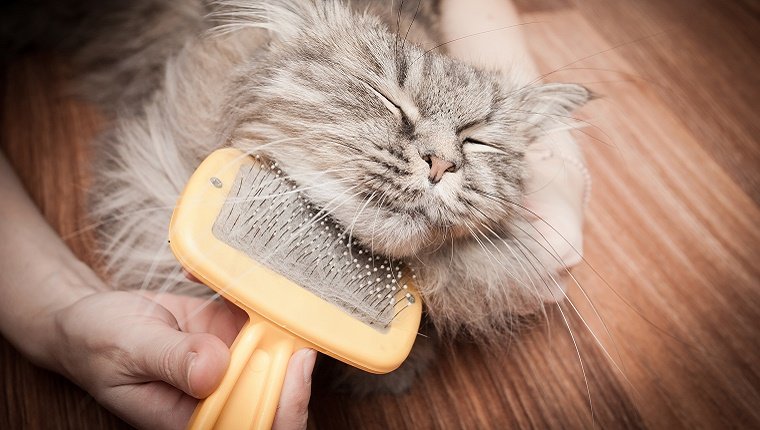October is National Pet Wellness Month. Supported by the American Veterinary Medical Association, the goal of this month is to educate pet parents on the importance of regular wellness exams and preventative healthcare.
Cats are pretty self-sufficient animals, but they still rely on us to take care of them and make sure they stay healthy. It’s our responsibility to get them to the vet, provide the right diet and exercise, and do all the things they can’t do for themselves.
Follow these tips to keep your cats happy and healthy during National Pet Wellness Month and throughout the year.
1. Schedule Your Annual Wellness Exam

There’s no question that annual checkups are important to your pet’s health, but 52 percent of cat parents go out of their way to avoid seeing the vet. According to a study conducted by Bayer and the American Association of Feline Practitioners, pet parents treat cats differently than dogs when it comes to wellness care.
Not only is it stressful to take a cat to the vet, but many cat lovers also believe their cats have never been sick. However, cats are great at hiding signs of discomfort, and annual check ups and lab work help catch serious illnesses early. Even indoor cats are at risk for diseases such as diabetes, heart conditions, and thyroid issues.
Here are some tips for making the trip to the vet easier on your cat:
- Before your appointment with the vet, get your cat to associate their carrier as a safe place. For example, leave their carrier out in the open, feed them only when they’re inside, or incorporate playtime around it.
- Many cats respond to Feliway, a synthetic cat pheromone used to minimize stress. Spray inside the carrier before your trip to the vet.
- Try to time your vet visits for after your cat eliminates into their litter box. This will help avoid messes during the car ride.
- Use a towel to cover your cat’s carrier to minimize stressful stimuli.
- Find a clinic that provides a separate entrance for cat parents or one who only treats cats. Not having to deal with barking dogs will go a long way toward keeping your cat calm.
- Don’t get stressed. Your cat will look to you for cues on how to react. They may hate going to the vet, but if you stay calm and collected, it will help make the visit more tolerable.
2. Keep Up With Dental Care
Imagine what your teeth would be like if you never brushed or flossed. Don’t let that happen to your cat’s teeth.
According to the American Veterinary Medical Association, most animals will suffer from early periodontal disease by the age of three. Advanced periodontal disease can even lead to kidney, liver, and heart issues.
Regular brushing is the most effective way to keep your cat’s teeth healthy. Not only will it halt the progression of periodontal disease, but it will also reduce the frequency of deep dental cleanings — an anesthetic procedure to clean below the gum line where most dental diseases occur.
When it comes to brushing your cat’s teeth, remember:
- Patience and training are key. Use plenty of treats and encouragement at every stage.
- Never use human toothpaste.
- If you have a particularly skittish cat, you’ll want to start with something as simple as stroking your cat’s cheeks with your finger. Progress to slipping a finger inside their mouth to rub their gums before introducing a toothbrush.
- The first time you use a toothbrush, let your cat come to you. Encourage them to explore or rub their cheeks against the bristle.
- Wait until your cat is in a relaxed state of mind before attempting to brush their teeth. For example, when you’re both already on the couch or when your cat is getting ready for their afternoon nap.
- Flavored toothpastes can be a great way to train your cat to associate teeth brushing with treat time.
3. Make Sure Your Cat Gets The Right Exercise & Diet

Keeping your cat at a healthy weight goes a long way toward ensuring they live a long and happy life, but according to a study done by the Association for Pet Obesity Prevention, over 50 percent of cats are either obese or overweight. Just like in humans, obesity can lead to diabetes, arthritis, and other diseases.
But how do you know if your cat is overweight? Most vets will used a nine point scoring system when they evaluate a pet’s body condition. A score of nine is obese and a score of one is emaciated.
You’ll want to aim for somewhere in the middle, ideally around a four. At this score, you should be able to feel their ribs beneath a thin layer of fat but not see them. You should also be able to see a well-defined waist behind the ribs when viewing the cat from the top down.
When it comes to keeping your cat at a healthy weight, remember:
- Consult your vet to rule out any medical issues for your cat’s obesity first.
- Set healthy weight loss goals. You don’t want your cat to lose weight too fast because it can lead to liver issues.
- A good goal to aim for is a loss of one to two percent of body weight per week.
- Make it a fun activity to ensure everyone follows the new feeding and exercise regimen. Put up a chart on the wall and do weekly weigh-ins. Every percentage lost is a win for the whole family.
- Play with your cat. For those of you with a cat who hates toys but loves food, throw a treat across the room to get them to chase after it. Just make sure you’re not feeding them a second meal’s worth of treats on top of their regular food.
- Use feeder toys. Make your own out of tennis balls or yogurt containers or buy them. Feeder toys not only encourage your cat to eat a smaller amount slower, they also provide enrichment. A cat in the wild will spend a lot of energy hunting and stalking their prey, and using a feeder toy will satisfy your cat’s need for physical and mental stimulation.
- Don’t free feed. Schedule regular, portion-controlled meals. You’ll be able to monitor how much your cat is eating or not eating, and having regular meal times will make it that much easier for those times when you have to give them medication.
4. Take Care Of Those Grooming Needs

While cats are known to be fastidious about their personal hygiene, sometimes you have to give them a helping hand. Senior or ill cats will require extra diligence on your part to keep them happy and comfortable.
When it comes to grooming your cat, remember:
- Do not cut matted fur out with scissors. Either gently comb them out with a dematting tool or take your cat to a professional groomer.
- Short-haired cats can get by with a once-a-week brushing, but longer-haired cats may require brushing every day to every other day.
- For skittish cats who don’t like to be groomed, you’ll need to go slow. Like the above tips for brushing your cat’s teeth, patience and training are key to getting your cat used to, and even to enjoy, being groomed.
- Get in the habit of examining your cat’s nails. Trim as needed. If nails grow too long, they can pierce your cat’s paw pads.
- For longer-haired cats, you may want to look into getting regular sanitary shaves done to eliminate a dirty or matted bottom.
- During warmer months, brush more frequently or even bathe to get rid of loose hair and minimize the number of hairballs your cat coughs up.
By focusing on preventative healthcare, you can ensure your cats are happy and healthy long after Pet Wellness Month is over.
What else do you do to keep your cat healthy? Are you taking any extra steps to care for your kitty in Pet Wellness Month? Share your tips with us in the comments below!









